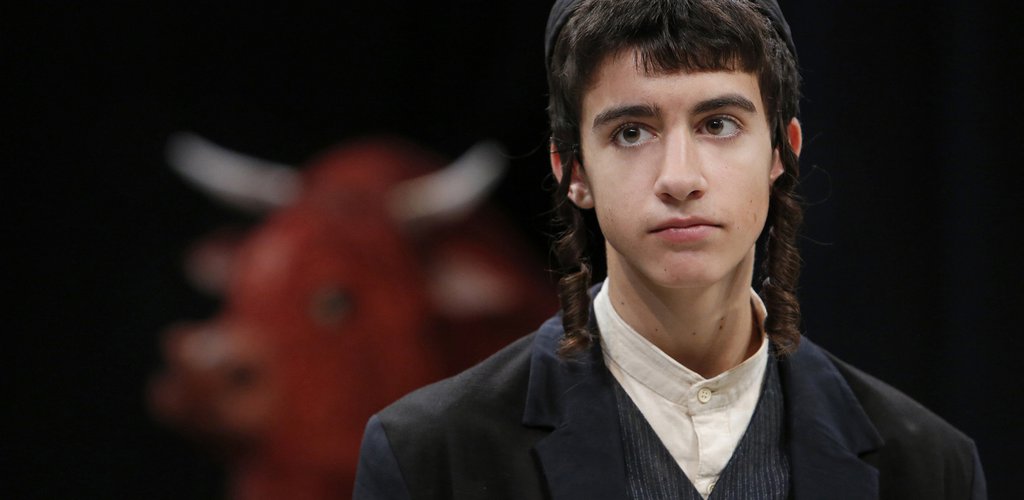As Fischer said in an interview (his words in one of the major Hungarian newspapers drew dozens of vitriolic comments online), ‘After my friend Miklós Erdély had created his marvellous film Verzió on the Tiszaeszlár blood libel affair in 1981, we planned that we would jointly make an opera version. The plan fell through because I worked abroad a lot and kept putting off composition work, which was unforgivable, and Erdély passed away in 1986. I have been thinking constantly about composing this opera for 25 years now. The Tiszaeszlár Affair becoming a present-day hot political issue finally helped me. The same responses, stereotypes and unreasonable prejudices appear nowadays as if we were back in the Red Cow Inn in 1883.’
The libretto draws on Gyula Krúdy’s novel A tiszaeszlári Solymosi Eszter, or Eszter Solymosi from Tiszaeszlár, in which a red cow features strongly and carries several layers of meaning. Much of the story is set in the local Red Cow Inn, whose renowned and free-spirited mistress was known as the Red Cow. Part of the story also tells of how a cow trod on Eszter’s toes, thus providing identifying evidence when her body was finally recovered, and the ‘Purification’ section of the opera quotes from the biblical book of Numbers, in which the ashes of a red heifer are used for ritual purification.
Premiered by Fischer’s celebrated budapest festival orchestra at the millenáris teátrum on October 13 as the second half of an evening of his works, the score emerged—appropriately enough, given Hungary’s ethnic melting-pot—as a mosaic-like mixture of styles. Most of Fischer’s music, indeed, aims to speak ‘everybody’s language’, and he steers away from the more hard-core ‘isms’ in favour of free-flowing collage. One of the works performed in the first half was his Tsuchigumo (The Monstrous Spider), a 20-minute opera in six languages premiered in Bruges in 2012. Derived from a Noh play, the work embraces everything from Monteverdian cantando to a Weill-like final chorus. A capacity crowd in the warehouse-like venue spilled over onto floor cushions, and the atmosphere was relaxed. This was a cultured, receptive audience, and, so far as Hungarian politics went, Fischer was probably preaching to the converted.
But The Red Heifer could— and should—travel, for it packs a powerful punch into its 50 minutes. After a bracing start, Krúdy (as in Janáček’s Brouček, the author is summoned up on stage) delivers his first monologue in recitative style, with organ accompaniment recalling Bach’s Passions. In one of many witty touches in the production (by Tamás Ascher and Kriszta Székely), the child actress playing Eszter then enters pulling on a life-size model heifer (designs were by Nóra Patrícia Kovács), and the scene quickly gives way to a party at the Red Cow Inn.
The folk styles begin to proliferate here in Fischer’s score (which makes direct use of only one extant song), calling for such instruments as the recorder-like tilinkó and the cimbalom, and using the orchestra’s well-established gypsy trio. A csárdás gives way to traditional Jewish music as Fischer transforms his orchestra into a kind of giant klezmer band. For such a dark story, there is a lot of joyful music. The testimony of Móric, the young boy coerced into testifying against his father, is turned into a rap with orchestral accompaniment, complete with building courtroom tensions. Played by Jonatán Kovács as a boy with peyos and a yarmulka, Móric is baited by a crowd (some in folk costumes, some in contemporary clothes) whose interjections are reinforced by vuvuzelas—a first for opera?
Fischer has stipulated that most of the roles should be taken by singing actors rather than opera singers, and some of the soloists (and chorus) sounded rough-edged; in particular the ballad-like songs of the Man were croaky in the best tradition of too much pálinka. Among the operatic voices, Orsolya Sáfár gave a vivid performance as the lively Innkeeper, a role in the lineage of Mussorgky’s Hostess at the Inn (Boris Godunov) and Tchaikovsky’s Kuma (The Enchantress), and Zoltán Megyesi disclosed a strong high tenor as the Judge. The most striking intervention was that of the bass Krisztián Cser, playing the great Lajos Kossuth with sculpted-voice authority, and speaking the character’s mind in words taken from Kossuth’s own letters after the Tiszaeszlár Affair. In the final scene Móric and his father József Scharf (Tamás Altorjay) are seen travelling on a train—the rhythms of which get louder and louder, leaving the audience to draw their own conclusions in the light of subsequent history.
Fischer’s form for The Red Heifer is all his own, but in a sense the work could only come from a country that has given us such pieces as Bartók’s Cantata profana and Kodály’s rather unconventional Singspiel Háry János. Bartók’s inclusiveness in his work (which embraces Romanian, Slovak and Hungarian sources) got him into a distasteful controversy in the 1930s, and Fischer is unlikely to be thanked for his idealism, either. Now his challenge will be to take it to other parts of Hungary, and to find a short opera with which to pair it. It’s a pity Weill’s Kingdom for a Cow isn’t shorter, but maybe fragments from the original but incomplete German version, Kuhhandel, could be pressed into service.
Opera magazine, January 2014
John Allison


